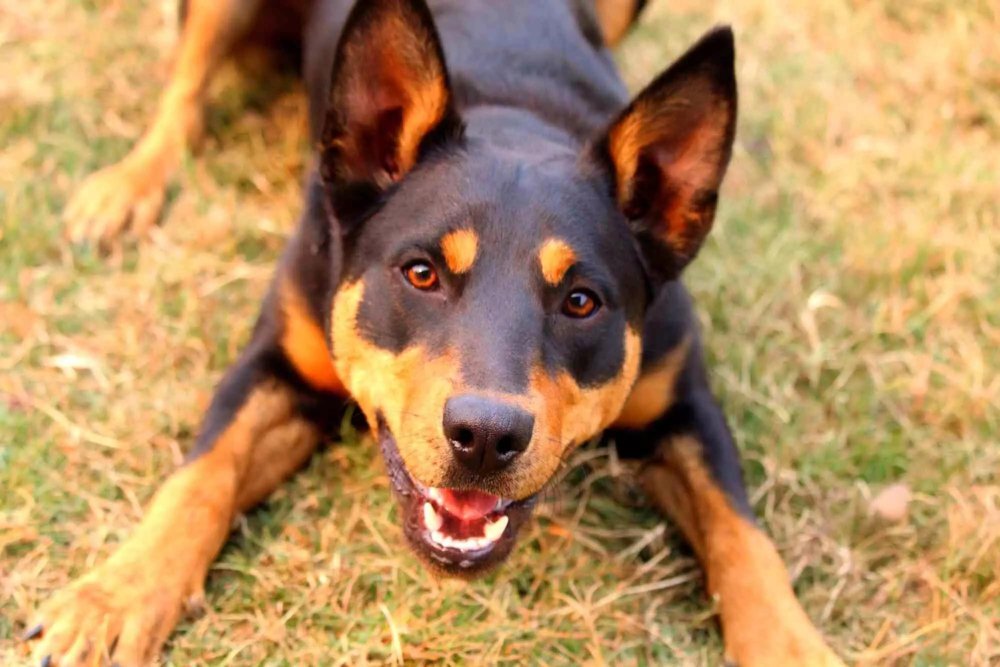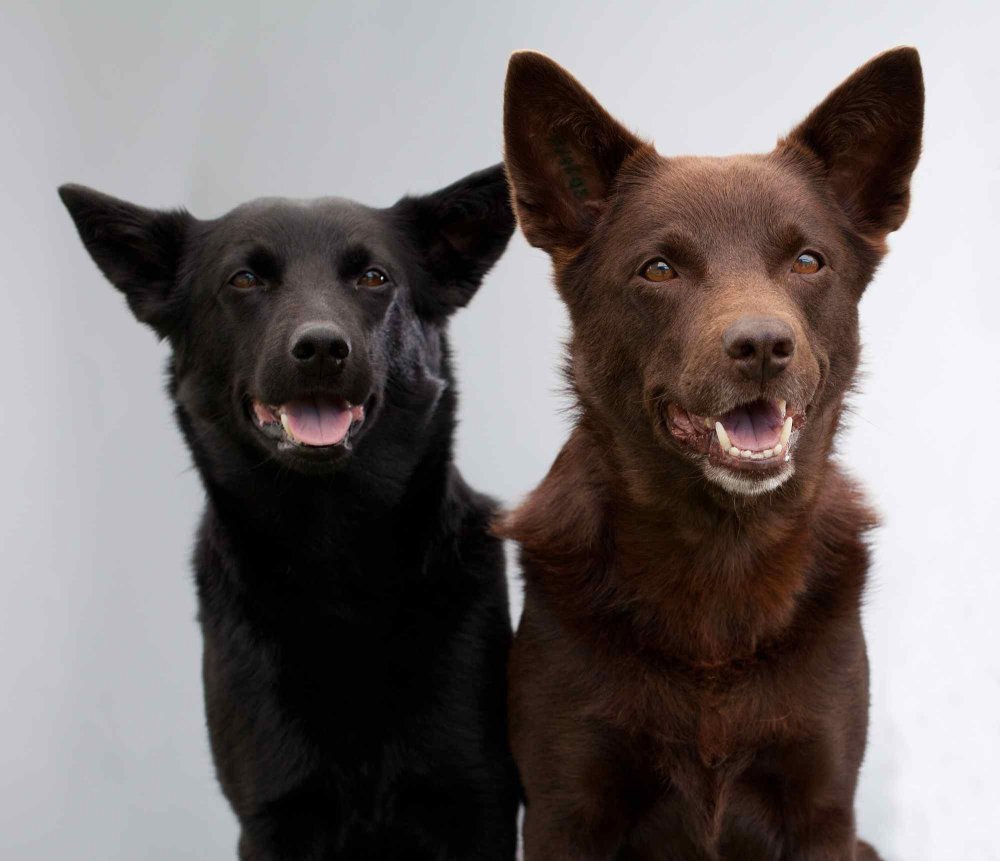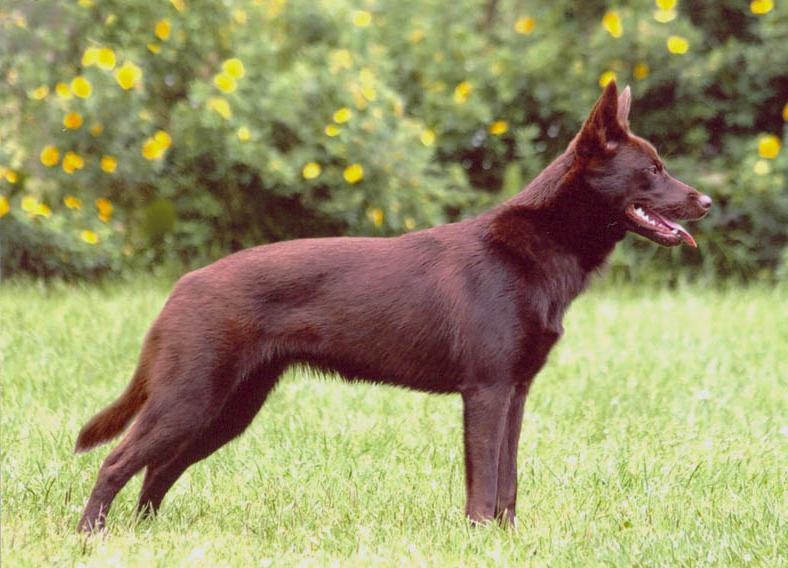- Breed Category: Working Dog
- Country of Origin: Australia
- Average Height: Males 46-51 cm, Females 43-48 cm
- Average Weight: Males 14-21 kg, Females 14-21 kg
- Average Life Span: 12-15 years
- Grooming Requirements: Low, occasional brushing
- Exercise Requirements: High, needs daily exercise
- Coat Type: Short, weather-resistant
- Coat Color Variations: Black, red, blue, fawn
- Shedding Level: Moderate
- Ear Type: Erect
- Tail Type: Medium length, slightly curved
- Temperament: Energetic, intelligent, loyal
- Intelligence Level: Very high
- Barking Tendency: Moderate
- Compatibility with Children: Good with proper training
- Compatibility with Other Pets: Generally good
- Training Ease: Highly trainable
- Common Health Issues: Hip dysplasia, progressive retinal atrophy
- Dietary Needs: High-quality, balanced diet
- Energy Level: Very high
- Drooling Tendency: Low
- Sensitivity to Weather: Tolerates heat well
- Overall Maintenance Level: Moderate
- Original Purpose: Herding livestock
- Year of Recognition by Kennel Clubs: 1903
- Apartment Friendly: Not ideal, needs space
- Best Suited For: Active families, rural settings
- Cost of Ownership: Moderate
- Unique Traits: Exceptional herding ability
- Cultural Significance: Iconic Australian working dog
- Popularity Rank: Popular in Australia
Ever found yourself wondering if your dog could keep up with your active lifestyle? Enter the Australian Kelpie, a breed known for its boundless energy and intelligence. This article dives into the Kelpie’s unique traits, rich history, and essential care tips. Originating in the late 19th century, the Kelpie was bred from a mix of British herding dogs and the native Australian Dingo. These dogs were designed to handle the harsh Australian outback, making them resilient and hardworking. Today, Kelpies are not just farm dogs; they excel in various roles, from agility sports to search and rescue. Understanding their background and needs is key to ensuring a happy, healthy life for these remarkable companions.
The Australian Kelpie: A Breed Built for the Outback

Early Development of the Breed
The Australian Kelpie’s journey began in the late 1800s, a time when Australian farmers needed a dog that could withstand the demanding conditions of the outback. By crossing British herding dogs with the native Dingo, breeders crafted a dog that was not only resilient but also incredibly intelligent and agile. This unique blend of genetics gave rise to a breed that could work tirelessly under the harsh Australian sun.
Role in Australian Sheep Farming
Kelpies quickly became indispensable in Australian sheep farming. Their ability to cover vast distances and manage large flocks with minimal guidance made them a farmer’s best mate. Even today, their natural herding instincts and stamina make them a staple on many Australian farms.
Key Historical Figures
Jack Gleeson and George Robertson are two names often associated with the Kelpie’s development. Their dedication to breeding a dog suited for the Australian landscape laid the foundation for the Kelpie’s success. Their efforts ensured that the breed was not only functional but also adaptable to various roles beyond farming.
Physical Characteristics
Physically, Kelpies are medium-sized dogs with a lean, muscular build. Their coat is weather-resistant, perfect for the unpredictable Australian climate. With alert, expressive eyes and a keen sense of awareness, they are always ready for action. Their agility and speed are matched by their intelligence, making them a versatile breed for various activities.
Appearance and Unique Traits of the Australian Kelpie

Distinctive Appearance
The Australian Kelpie is a medium-sized dog, typically weighing between 14 to 20 kilograms. Its coat can vary in colour, including black, red, chocolate, fawn, and blue, often with distinctive tan markings. The coat is short and weather-resistant, ideal for the unpredictable Australian climate. Their eyes are alert and expressive, reflecting their keen intelligence and readiness for action.
Agility and Endurance
What truly sets the Kelpie apart is its remarkable agility and endurance. These dogs are built for speed and can cover vast distances with ease. Their lean, muscular build allows them to navigate rough terrains effortlessly, making them perfect for herding and other demanding activities. Whether it’s a long hike or a day at the agility course, Kelpies thrive on physical challenges.
Temperament and Behaviour
Kelpies are known for their intelligence and eagerness to work. They are highly trainable and excel in obedience and agility sports. While they are independent thinkers, they form strong bonds with their owners and are incredibly loyal. Their natural herding instincts mean they are always alert and ready to take on any task, making them excellent companions for active individuals or families.
Personality and Suitability of the Australian Kelpie

Typical Personality Traits
The Australian Kelpie is renowned for its loyalty and intelligence. These dogs are quick learners, always eager to please, and have a natural instinct for herding. Their high energy levels mean they’re always ready for action, making them perfect for those who love the outdoors.
Suitability as a Family Pet and Working Dog
Kelpies are versatile, fitting well into both family and working environments. Their loyalty and protective nature make them great family pets, while their intelligence and stamina are ideal for working roles. They thrive in active households where they can participate in regular activities.
Interaction with Children and Other Animals
With proper socialisation, Kelpies are generally good with children and other animals. Their herding instincts might lead them to try and ’round up’ kids or pets, but with training, they can learn to interact gently and playfully.
Training and Exercise Needs
Training a Kelpie is usually straightforward due to their intelligence and eagerness to learn. They require consistent mental and physical stimulation, so regular exercise and training sessions are essential. Activities like agility courses or long hikes are perfect for keeping them engaged and happy.
Training, Exercise, and Health of the Australian Kelpie

Importance of Early Training and Socialisation
Getting a Kelpie off to a good start with early training and socialisation is crucial. These dogs are smart and pick up on things quickly, so introducing them to different environments, people, and other animals early on helps them grow into well-rounded adults. It’s all about setting the right foundation.
Recommended Training Techniques
When it comes to training, positive reinforcement is the way to go. Kelpies respond well to rewards and praise, making them eager learners. Consistency is key, so regular training sessions that challenge their minds will keep them sharp and engaged.
Daily Exercise Requirements and Activities They Enjoy
Kelpies are high-energy dogs that need plenty of exercise. Think long walks, runs, or even agility courses. They love activities that challenge both their bodies and minds. A bored Kelpie can become restless, so keeping them active is essential.
Health and Lifespan
Generally, Kelpies are healthy dogs with a lifespan of around 12 to 15 years. Regular vet check-ups and a balanced diet help maintain their health. Like any breed, they can be prone to certain genetic conditions, so keeping an eye on their health is important.
Health and Care of the Australian Kelpie

Common Health Issues
While Australian Kelpies are generally robust, they can be prone to certain health issues like hip dysplasia and progressive retinal atrophy. Regular vet check-ups are crucial to catch any potential problems early. Keeping an eye on their weight and ensuring they get enough exercise can help prevent joint issues.
Average Lifespan and Health Tips
Kelpies typically live between 12 to 15 years. To keep them healthy, a balanced diet and regular exercise are key. These dogs thrive on activity, so engaging them in daily physical and mental challenges is essential. Regular grooming and dental care also contribute to their overall well-being.
Preventative Care Recommendations
Preventative care is all about staying ahead of potential health issues. Regular vaccinations, flea and tick prevention, and dental check-ups are important. Keeping their ears clean and monitoring for any signs of infection can prevent common ear issues.
Grooming and Maintenance
Kelpies have a short, weather-resistant coat that requires minimal grooming. A weekly brush will keep their coat healthy and reduce shedding. Regular nail trimming and ear cleaning are also part of their grooming routine. Despite their low-maintenance coat, they do appreciate a good bath after a day of adventure.
Coat Care and Grooming for the Australian Kelpie

Coat Care and Grooming Routines
The Australian Kelpie’s coat is designed to handle the elements, but it still needs some attention. A weekly brush is usually enough to keep their coat looking its best and to remove loose hairs. This not only keeps them looking sharp but also helps distribute natural oils, keeping their skin healthy.
Shedding and Seasonal Grooming Tips
Kelpies do shed, especially during seasonal changes. During these times, you might want to increase brushing to a couple of times a week. This helps manage the shedding and keeps your home a bit tidier. A good bath every now and then, especially after a muddy adventure, will keep them fresh.
Diet and Nutrition
Feeding your Kelpie a balanced diet is crucial for their health and energy levels. High-quality dog food that meets their nutritional needs is a must. These active dogs benefit from a diet rich in protein to support their muscles. Always ensure they have access to fresh water, especially after exercise.
Nutritional Needs and Feeding for the Australian Kelpie

Nutritional Needs for Optimal Health
Australian Kelpies are active dogs, so they need a diet that supports their energy levels. High-quality dog food with a good balance of protein, fats, and carbohydrates is essential. Protein is particularly important to maintain their muscle mass and support their active lifestyle.
Foods to Include and Avoid
Include lean meats, fish, and vegetables in their diet for a well-rounded nutritional profile. Avoid foods high in fillers, artificial additives, and excessive grains, as these can lead to weight gain and other health issues. Always ensure they have access to fresh water.
Feeding Schedules and Portion Recommendations
Divide their meals into two portions a day to maintain their energy levels. The exact amount depends on their age, weight, and activity level, but generally, an adult Kelpie will need about 1.5 to 2.5 cups of dry food daily. Adjust portions based on their activity and health needs.
Fun Facts and Trivia
Did you know that the Australian Kelpie can run up to 60 kilometres in a single day? Their stamina is legendary, making them perfect companions for those who love outdoor adventures. Despite their working dog roots, Kelpies are also known for their affectionate nature and loyalty.
Famous Australian Kelpies in Media and History

Notable Kelpies in Film and Television
The Australian Kelpie has made its mark in the world of film and television. One of the most famous Kelpies is “Red Dog,” a legendary figure in Australian folklore. Red Dog’s story was immortalised in a popular film, capturing the hearts of audiences with tales of his adventures across the Pilbara region. This film highlighted the breed’s loyalty and adventurous spirit, traits that resonate with many Kelpie owners.
Historical Contributions
Beyond the silver screen, Kelpies have played significant roles in Australian history. During the early 20th century, they were essential in the development of the Australian sheep industry. Their ability to manage large flocks with minimal supervision made them invaluable to farmers. This contribution helped shape the agricultural landscape of Australia, cementing the Kelpie’s place in the nation’s history.
Interesting Tidbits
- Kelpies are known for their incredible stamina, capable of working tirelessly for hours on end.
- They have a unique ability to “back” sheep, meaning they can run across the backs of tightly packed flocks to reach the other side.
- The breed’s name is believed to have originated from a Scottish water spirit, reflecting their mysterious and energetic nature.
Final Thoughts

The Australian Kelpie is a remarkable blend of energy and intelligence. This breed’s resilience and versatility make it an ideal companion for active lifestyles. From herding livestock to excelling in agility sports, Kelpies thrive on challenges and form strong bonds with their owners. Understanding their needs and providing proper care ensures a fulfilling life for these loyal dogs. Embrace the adventure of owning a Kelpie and experience the joy of a truly dynamic partnership.
